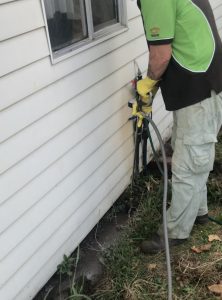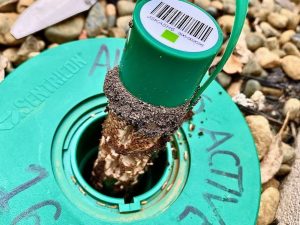Homeowners who are concerned about the threat of termites will often ask, “What’s the best termite treatment?” Unfortunately there isn’t a single answer to this, as a number of factors come into play. Some considerations include:
- Termite status: are termites currently inside the building? If so, which species is present and how did the termites gain entry?
- Construction: the age of the property and construction type, for example whether the home is built on a concrete slab or stilts
- Environment: soil type, topography of the surrounding land and local climate (a home located in a flood-prone area will have different requirements to a home built on a slope)
If termites are inside your home then the first step is to find them and treat them. This means 1) trying to locate and destroy the nest and 2) using a termiticide product to eliminate any termites inside the building.
1. Locating and Destroying the Termite Nest
The main pest termites in Australia are subterranean insects, which mean they live and nest underground. Their nests can be very challenging to locate as they are typically well hidden, either underground or in tree trunks up to 100 metres away! If the nest can be located, it can be quickly and easily destroyed by injecting with insecticide.
Even if the nest can be found and treated, in many cases it is not possible to determine whether it is the same nest that is attacking the building and so it will also be necessary to treat any active termites inside the building.
Of course, yf the nest cannot be located (which is often the case despite thorough searching), the treatment will focus on eliminating any termites from the structure.
2. Treating Termites Inside the Building
A number of professional termite products have been developed to allow for treatments in various locations and situations. The chose or product is influenced by the species of termites, their location in the building and the numbers of termites present. Each product has its pros and cons.
Termite dusts are excellent in situations where there is significant termite activity and their workings are relatively dry. This allows the dust to float through the workings and coat a large number of termites. The dust is passed on to other termites magnifying its affect. Although this is sufficient to eliminate the termites from the structure in as little as a couple of weeks, it is unlikely to eliminate the nest, unless it is nearby.
Termite foams are similar in their mode of action to dusts, but have the advantage of being suitable for use in damp or humid areas. They are typically used when termites are active inside wall cavities as the foam expands to fill the space. As with dusts, foam treatments can eliminate termites in about 3 weeks, but are also unlikely to kill the nest.
Termite baits are the only method proven to consistently eliminate termite nests. While dusts and baits will kill the termites that come into contact with the product, they only work in the area in which they are applied. Termite baits work by using the termites to carry the insecticide right into the heart of the termite nest, where it is fed to the other termites, including the queen. Although baits will eliminate the nest and therefore reduce the termite pressure on the house, it can take 3 months or more to kill the nest completely. More information on how termite baits work…
Whether the nest has been eliminated or not, once the termites have been eliminated from the building, it is necessary to install a termite management system to prevent future termite attacks.
Installing a Termite Management System
Any homeowner who has experienced termite damage will be quick to take action to prevent termites returning. This is where a termite management system comes in.
For termite treatments in Melbourne, two main options exist:
- Liquid soil treatments: where a termiticide product is applied to the soil around the property
- Baiting systems: where bait stations are installed in the ground around the perimeter of the property
For some homeowners it’s possible that both of these systems will be suitable for the property and you can make a decision about which you would prefer. However for some properties – due to the soil type, the species of termite that is present or construction style of the building – only one of the systems may be suitable.
Liquid Soil Treatments
At Termites VIC we use termite soil treatments to protect properties where baiting may not be suitable or desirable. It involves drilling holes into the soil around the perimeter of the property and mixing in or injecting a professional-grade termiticide liquid. This liquid mixes with the soil (the termiticide physically binds to the soil particles) resulting in an invisible termiticide barrier around the home. The soil has to be treated all the way down to the foundations. As you can imagine, the larger the house and the deeper down we need to dig and treat the soil, the more expensive the treatment becomes.
Pros: Lasts for 5-8 years. Only needs an annual termite inspection to maintain the warranty
Cons: More expensive to install than a baiting system, even more so if a sub-floor is present. Cannot be applied in certain soil types or a steeply sloping block. Acts as a “termite barrier” preventing termite entry, it does not kill the nest.
Termites VIC only use Termidor, the leading termite soil treatment product on the market and can offer the $2 million Termidor Assurance Warranty.

Baiting Systems
Installing a baiting system means placing bait stations in the ground at regular intervals around the perimeter of the property. Termite baits are placed in each bait station, meaning the bait stations are active from the day they are installed. If termites are foraging nearby, they will be drawn to the bait stations, consume the bait and take it back to the nest – the termite nest is eliminated within a couple of months.
Pros: Cheaper and quicker than a soil treatment to install. Actually kills termite nests in the area, reducing the termite pressure on the property. Low environmental impact, as no insecticide is applied to the soil.
Cons: More expensive than soil treatments to maintain, as the system needs regular inspections as well as the annual termite inspection for the property.
Termites VIC only use one of the two leading products, either Trelona Termite Bait or Sentricon AlwaysActive.

So which termite treatment is the best, soil treatments or baits? The answer is, it depends – it depends on the house construction, the soil type, budget considerations and any personal preferences. At Termites VIC, we will look at your home as an individual case, and will take you through the termite treatment options that are suitable. This will allow you to make an informed choice about what’s right for you and your home.
More on termite treatments…
